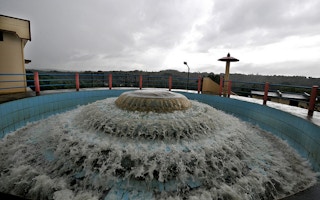By 2025, it is predicted that two thirds of the global population will face water shortages, with 14 of the world’s 20 megacities currently experiencing water scarcity or conditions of drought. A majority of the four billion people who annually experience water stress are in India and China, two of Asia’s largest and fastest growing economies.
To continue reading, subscribe to Eco‑Business.
There's something for everyone. We offer a range of subscription plans.
- Access our stories and receive our Insights Weekly newsletter with the free EB Member plan.
- Unlock unlimited access to our content and archive with EB Circle.
- Publish your content with EB Premium.
It takes water to make most things work and keep modern civilisation up and running. Industries that support our basic needs, such as agriculture, energy and manufacturing use copious amounts of water, and population growth over the years has added additional pressure on the global water supply.
Climate change has further exacerbated the current water challenges by disrupting the Earth’s natural water cycle, and altering the time, quality and location of precipitation. In the Himalayas, erratic weather conditions and melting glaciers are affecting livelihoods in the lowlands that depend on stable patterns of snow and rainfall.
A third of the Himalayan glaciers are projected to melt by the end of the century, putting water sources for close to 2 billion people in the region at risk.
Urban centres such as Cape Town also face increased risk from extreme weather events. In 2018, the combination of high water demand, economic growth and a three-year drought pushed the city towards Day Zero, the day thought to be the biggest municipal water failure in modern history.
“You can’t talk about climate change without talking about water,” Piers Clark, Chief Executive Officer of Isle Group Ltd, a technology and innovation consultancy, said on a panel at the Ecosperity Conference in Singapore.
According to Clark, the issues associated with water are “different from what we’ve seen with power” and that problems of scarcity and quality plague the world’s water supply today.
“There is not enough water and as we head into a more intense climate there’s going to be less water available at the times that we need it,” he added. “The quality of the small amount of water that we have left also is getting harder to maintain because of what we’re doing to the planet.”
Around the world, poor waste management and weak infrastructure contribute to contamination of the world’s surface and groundwater. In India, an approximately 200,000 people die each year from consuming polluted water.
Even in developed economies, more can be done to improve water management and efficiency, especially in light of the risks associated with climate change, according to the panellists.
“
There is not enough water and as we head into a more intense climate there’s going to be less water available at the times that we need it.
Piers Clark, Chief Executive Officer, Isle Group Ltd
The future of water lies in innovative tech
Pipes made of lead, wood and stone were once used as underground channels to distribute water to a network of home, building and service systems.
Helge Daebel, Investment Director of clean energy investment company Emerald Technology Ventures, predicts that in the near future, water pipes equipped with artificial intelligence will be able to assess material conditions and identify areas of stress and corrosion.
This would help prevent leaks and help eliminate costs by 80 per cent, as users can act in advance to replace faulty parts, instead of digging up the entire pipe.
“Today the water industry is experiencing exponential growth. Everything we do can now be done within a fraction of the cost it was a decade ago,” said Daebel, “By adopting technologies that have been field tested and are available in the market, we can put them in place at every water utility in the world.”
George Hawkins, who pioneered a programme that converts solids from wastewater into methane gas at the world’s largest on-site, waste-to-energy power plant, referred to wastewater as a valuable asset that is both sustainable and profitable.
The former Chief Executive Officer of the District of Columbia Water and Sewer Authority (DC Water) and President of innovation consultancy Moonshot Partners, also said that every waste facility in the world has the ability to generate power and the potential to be one of the biggest sectors for energy production.
Francois Fevrier, who heads waste and water management company SUEZ Asia’s Water Asia business, said, “The revolution of water is coming from big data, with which we can use to optimise the management of water and bridge the water supply gap.”
Fevrier shared his company’s work with Singapore’s Public Utilities Board in using an enhanced data-based platform to monitor rainfall as well as the quality and quantity of water in the country’s canals, allowing one of Southeast Asia’s most resource-scarce countries to effectively manage its water resources.
According to Hawkins, the future is bright for the water sector, as global challenges present new opportunities to innovate and address inefficiencies in current water systems.
“Water is associated with every life form. It is where climate change will be reflected first, but it is also the place where the best opportunities lie,” he said.
Check out more content from Ecosperity Week by visiting Ecosperity.sg.








